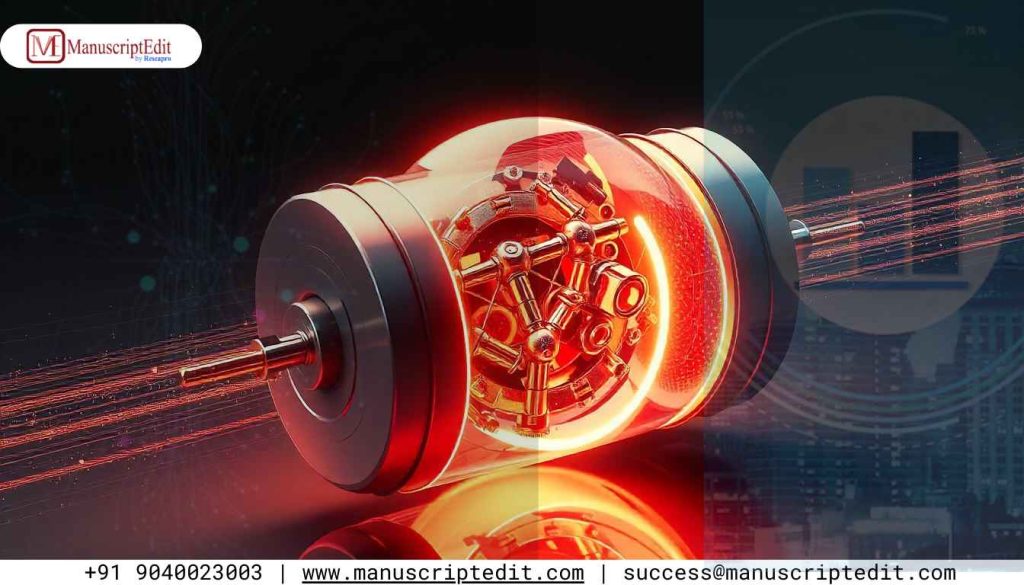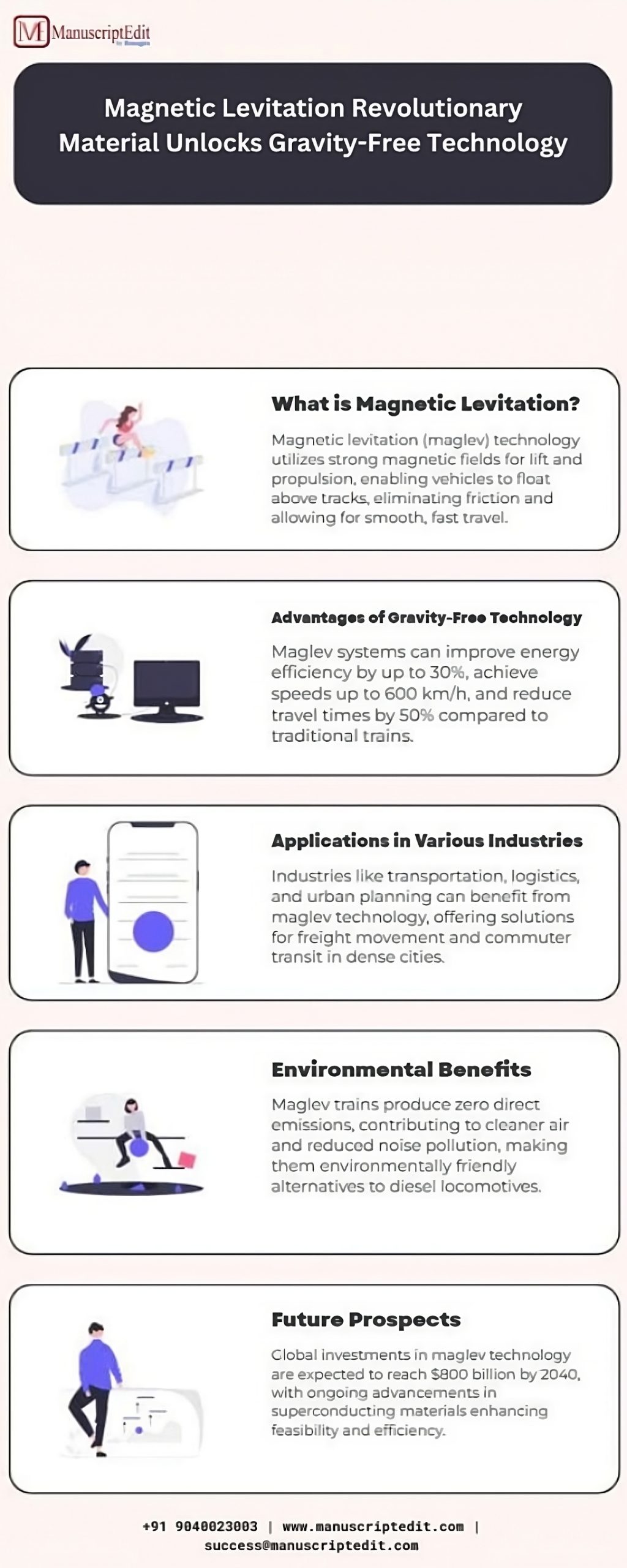
What is Magnetic Levitation?
Imagine a world where cars glide silently over roads, trains reach speeds that defy the limits of current transportation, and energy is transmitted wirelessly with zero loss. While these ideas may have once seemed like science fiction, advances in magnetic levitation maglev technology are making them a reality.

Magnetic levitation, or maglev, is the process of using magnetic forces to lift and propel objects, overcoming the pull of gravity. You may have heard about maglev trains, which use powerful magnets to float above tracks, eliminating friction and enabling high-speed travel . But the exciting part is that the latest advancements in materials science are pushing the boundaries of what’s possible, and these new materials are poised to unlock a whole new wave of innovative applications.
The Revolution-Making Material
Researchers have developed a new material that improves the efficiency of magnetic levitation and its scalability. This compound has superconducting properties combined with lightweight strength and unmatched magnetic field control. It solves long-standing problems, such as energy usage and magnetic field stability.
The main properties of this material are:
Precise Magnetic Control: It allows for precise control of magnetic fields, which is critical for achieving stable levitation and dynamic motion.
Energy Efficiency: It decreases resistance and increases magnetic strength, which in turn results in a significant reduction in the energy needed for levitation.
Scalability: Its versatility makes it applicable to large-scale systems, like transportation, as well as to small-scale innovations in electronics.
Revolutionary Applications
This new material has the potential to revolutionize many industries. Here are some of its most promising applications:
High-Speed Transportation: Maglev trains, known for their speed and smooth operation, can be faster and more energy efficient in today’s time. The magnetic control systems will enable travel at extraordinary speeds, regardless of fuel consumption, making travel times much shorter. Future generations of maglev trains can be designed to reach speeds of more than 600 km/h with energy efficiency that surpasses rail and air travel methods.
Advanced Manufacturing: Friction and contamination can be eliminated in levitation-based manufacturing processes, which can be used to produce delicate components with unique precision. This is particularly useful for industries like semiconductor fabrication, where microscopic precision is of the utmost importance. The material’s ability to provide stable levitation can reduce waste and enhance the quality of manufactured goods, especially in electronics, optics, and nanotechnology.
Medical Breakthroughs: Maglev technology can be used to improve imaging devices, enable exact surgeries, and even create artificial organs in a low-gravity environment. For example, maglev-based imaging machines could provide greater resolution and quicker diagnostics by minimizing mechanical interference. Also, a gravity-free environment enabled by maglev could lead to tissue engineering advancements, allowing scientists to create intricate organ structures more precisely.
Energy Storage: By improving the efficacy of energy storage systems, magnetic levitation could make renewable-energy solutions more compact and reliable. Large discs, or flywheels, which rest on friction-free bearings, spin to store up energy in some flywheel-based energy storage systems. This innovation could help significantly reduce energy lost in these energy storage systems and would provide a much clearer path for grids powered by wind and solar plants.
Space Exploration: Such a material could even help in space exploration where magnetic levitation is seen as an opportunity in the assembling of spacecraft and other equipment in zero gravity. The cost of launching payloads into space may also decrease with the use of maglev launch systems.
Obstacles in Its Development
Many problems exist with this material that must be overcome before its widespread use can be achieved. To become economically viable, the cost of production must be lowered. The processes and materials necessary to create these superconducting composites often are expensive and complicated, thereby limiting its further application. Research is being performed to simplify production and develop lower-cost alternatives with similar performance capabilities.
Further, the material, if integrated into present maglev systems, would be a tremendous undertaking. Tracks would have to be rebuilt, along with supporting electronics and infrastructure. That would require a lot of investment, which would probably require interagency collaboration among government, private industries, and research institutions.
In conclusion, thorough testing is necessary to ensure the material’s strength in practical use. The aspects that need to be examined with great detail include temperature fluctuations, degradation due to usage, and environmental exposure for sustained reliability and security.
A Future-Defying Gravity
This advanced material represents a giant leap forward in the hunt of gravity-free technology. It addresses some of the critical challenges in magnetic levitation, unraveling innovations that were once confined to science fiction-from transforming transportation to developing medicine.
As researchers are trying to perfect this material and practitioners incorporate it into practical applications, we may soon live in a future where gravitational forces no longer hold us back. Innovative dream-like concepts like floating cities, frictionless travel, and increased space exploration which may become a reality within our lifetime.
Now imagine how truly revolutionary this technology is. Its ability to transform industries and uplift lives is unmatched. While challenges remain, the progress made thus far is a testament to human ingenuity and the power of innovation. Standing at the threshold of a gravity-defying world, the question is not if but when we will fully realize magnetic levitation.
How the World is Preparing for This Material?
Countries worldwide are competing to incorporate this revolutionary material into their respective sectors. The following details the initiatives being taken around the world:
Research and Development: Powerful nations, such as the United States, Germany, and Japan, have increased research and development spending to fully capitalize on this resource. Educational institutions and research centers are conducting tests to understand its properties and finding new uses.
Transportation Initiatives: Currently, this material is being studied to be used for upgrading existing infrastructure in countries like Japan and China. The Japanese Chūō Shinkansen maglev line as well as the Shanghai Maglev in China would be tremendous opportunities for this technology to reach greater velocities at significantly lower operating costs.
Public-Private Partnerships: Public authorities have engaged the private sector to hasten the commercialization of this material. Collaborations between major technology players and transportation groups are steering innovations in new maglev trains and urban mobility concepts.
Energy Integration: Developed or developing countries with highly ambitious renewable targets, such as Germany and Denmark, have incorporated energy storage solutions that go in parallel with the maglev systems. The ability to stabilize power grids and more practically generate renewable energy replacements can be ensured through this material.
International Cooperation: Cross-border initiatives are being set up to share knowledge and experience. Organizations like the International Energy Agency (IEA) and the European Space Agency (ESA) are encouraging discussions on how this knowledge can be used for industries from transportation to space research.
Legislation and Regulation: Regulators are developing policies to ensure that maglev technologies are used safely and responsibly. These policies set standard applications but also consider environmental and safety issues.
This noteworthy achievement in material science reflects very good progress that is made toward the discovery of gravity-free technology. It allows innovations to be appreciated which, until now, have lived only in the realm of science fiction by tackling some of the most critical concerns with magnetic levitation. A developing country like India, with a huge population and different challenges in all aspects, will find a product of this nature to be profoundly transformative.
As researchers continue to improve this material and engineers incorporate it into working applications, India will be dignified to become a leader in the use and exportation of magnetic levitation technologies. The dream of airborne urban environments, frictionless travel, and advanced space exploration may become a reality in our lifetime because of this fantastic breakthrough in materials science.
This technology can bring about a revolution in industries and significantly improve the quality of people’s lives across India. The various successes already achieved will, by themselves, attest to the ingenuity of human beings as well as the potential to innovate further, given the right momentum. With its scientific know-how and entrepreneurial zeal, India can seize this incredible discovery as a foundational part of its technological and economic trajectory. The question here is not so much about if but when, the real power of magnetic levitation will find actualization within the Indian context.
A world defying gravity is no longer a flight of fancy. Magnetic levitation, powered by breakthroughs in material science, will reshape industries, redefine transportation, and unlock possibilities in medicine, energy, and space exploration. While there are still challenges regarding cost, scalability, and integration, the progress so far achieved testifies to human ingenuity and relentless innovation.
This revolutionary material is a point in technological evolution where science fiction became real. And with nations investing in research, forging public-private collaboration, and starting to integrate into infrastructure and industry, the potential to transform lives and thrust economies forward can no longer be denied.
With scientific know-how and the spirit of entrepreneurship, India is uniquely positioned to embrace and, in fact, lead this technological revolution. Be it frictionless urban mobility or sustainable energy solutions, magnetic levitation holds great potential for solving many critical challenges that will improve the quality of life for millions.
But as humankind stands literally on the cusp of a future that has little use for gravity, the question no longer is if magnetic levitation will transform our world, but how. Such a boundary-breaking technology foreshadows a time in life where gravity limits no longer affect mankind’s activities.



